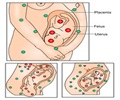University of Cincinnati’s Danielle Bessett will be presenting a new study at the 108th Annual Meeting of the American Sociological Association.

The study relied on interviews with 64 pregnant women in the greater New York metropolitan area from 2003-2006. Bessett noted that all 64 women confronted mythologies in pregnancy.
"In contrast to survey research that asks women to identify information sources that help them make specific decisions, in-depth interviews such as mine reveal a more complex web of taken-for-granted assumptions that women bring to pregnancy — a condition commonly represented in both fictional and reality television, films, commercials, and other entertainment media," Bessett said. "My research shows that we may underestimate the extent to which all of us hold understandings of pregnancy built incrementally through a succession of ephemeral encounters over our lifetimes and the extent to which those understandings affect us. It is important to recognize this phenomenon because it may result in different perspectives on what we can take for granted about pregnancy which may affect communication between women and their health care providers."
According to Bessett, some women drew heavily from ethnic-religious traditions. Some had little or no personal experience with pregnancy, while others had complicated reproductive histories. "Depending on these varied biographical and structural locations, women affirmed, grieved, critiqued, and contested key aspects of pregnancy mythology," Bessett said.
Bessett found that most women tended to minimize the influence of pregnancy mythologies when asked directly about information sources they trusted most. It was only when pushed to explain how they came to hold specific expectations for what would happen during their pregnancies that women referenced entertainment media sources. Interestingly, women often found themselves without an explanation for how they learned about what "normally happened" in pregnancy.
Through her interviews, Bessett found that in some cases, women were alarmed when they weren't experiencing symptoms popularly associated with pregnancy, such as morning sickness, fearing that something might be wrong with the health of the fetus.
Advertisement
For example, one mother said that her intense vomiting resulted because her baby didn't like what she ate. Another explained that her craving was due to her baby "liking fried chicken."
Advertisement
While issues such as nausea, cravings, and labor pain were prominent in mythology, Bessett said that other ailments such as exhaustion, insomnia, gas, headaches, and swollen ankles weren't as popularly linked or discussed.
"Whether it's because they are somewhat rare (like pregnancy-related nosebleeds) or because they concern parts of the body that are not 'polite' to talk about (such as hemorrhoids), some symptoms are not typically portrayed in entertainment media narratives on pregnancy, nor were they symptoms that friends and family frequently shared with women in advance of their first pregnancy," she said.
Study Participants
The findings from the study are based on interviews with 64 pregnant women in the greater New York metropolitan area from 2003-2006. All participants were enrolled in prenatal care at the time of the interviews. Just over half of the participants were expecting their first child. Twenty-three of the participants sought care from public, hospital-based clinics, while the other participants received care from private practices. The women represented a range of socioeconomic and racial/ethnic backgrounds.
Just over half of the women interviewed identified as white; 12 as black; 14 as Hispanic/white; two as Hispanic/black; two as Asian; and one as other/mixed race. The sample was economically diverse, with a third of the women reporting household incomes of less than $40,000 and just under half reporting household incomes of $80,000 or higher.
Participants agreed to at least two interviews — one before and one after giving birth, yet most participants took part in three interviews.
Source-Eurekalert















